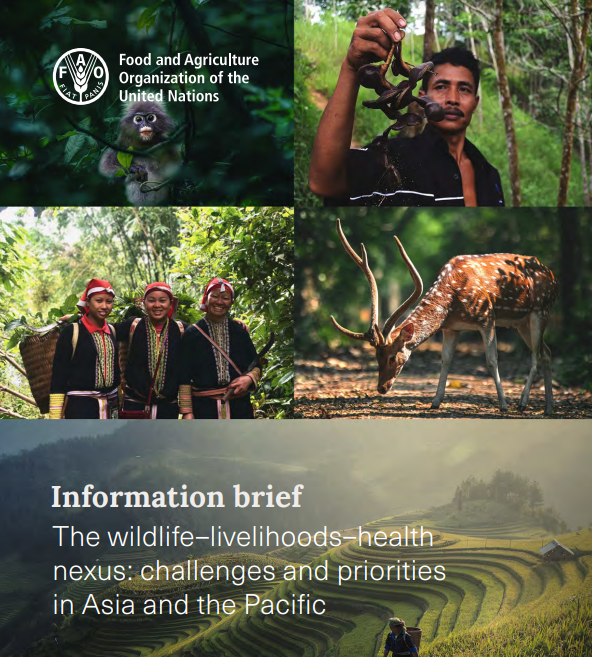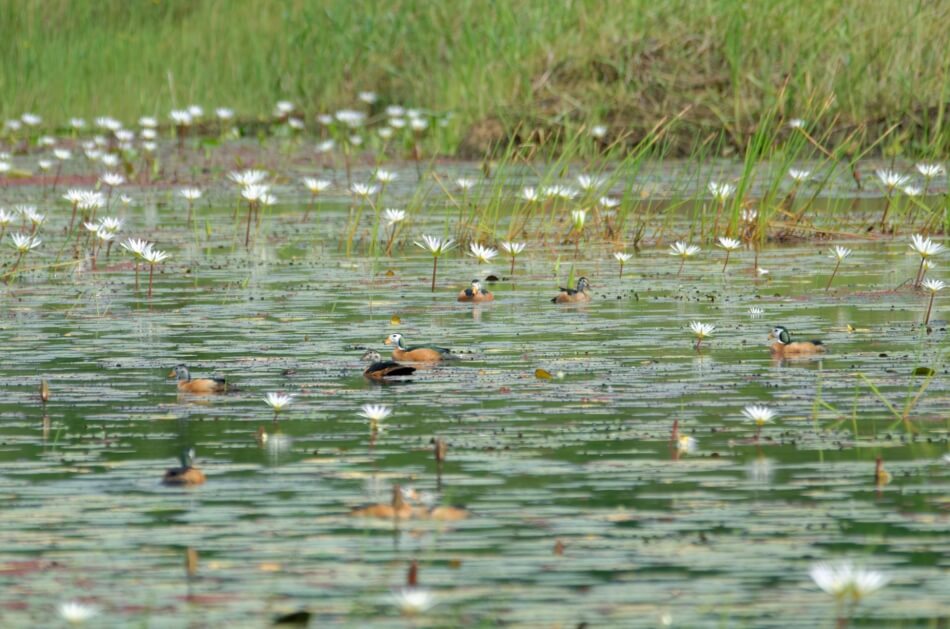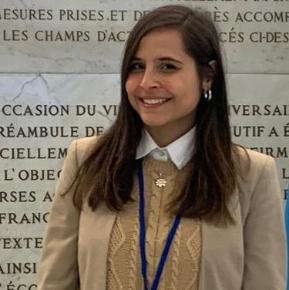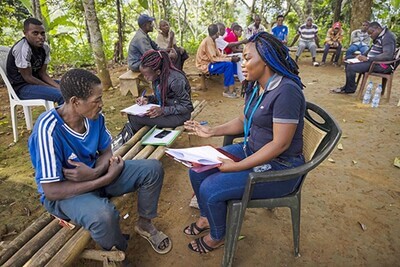Supporting and strengthening Community Conservancies in Southern Africa

Reducing human-wildlife conflict and improving coexistence
8 juillet 2024
Reducing human-wildlife conflict and improving coexistence
8 juillet 2024
Human-wildlife conflict and coexistence (HWCC) is an increasingly critical issue for conservation and rural communities. As human populations encroach into wild areas, conflicts arise, making effective management strategies essential for the safety of both people and wildlife.
The Sustainable Wildlife Management (SWM) Programme, which is funded by the European Union, with co-funding from the French Facility for Global Environment and the French Development Agency, has been making significant strides in addressing HWCC through its innovative training of trainer workshops. These workshops exemplify the SWM Programme’s commitment to fostering coexistence between humans and wildlife, particularly in the Kavango–Zambezi Transfrontier Conservation Area (KAZA TFCA), where such conflicts impact both conservation efforts and community livelihoods.

©CIRAD/Mathieu Bourgarel
Happy Biodiversity Day!
22 mai 2024
Happy Biodiversity Day!
22 mai 2024
Join us in celebrating the International Day for Biological Diversity by exploring the remarkable biodiversity conservation efforts made by the Sustainable Wildlife Management (SWM) Programme. This year’s theme, “Be part of the Plan,” emphasizes the urgent need for all stakeholders to halt and reverse the loss of biodiversity by supporting the implementation of the Kunming-Montreal Global Biodiversity Framework.
- Read our latest Guyana publication, a collection of engaging articles on the technical and scientific work completed by the SWM Programme in Guyana Region 9 between 2018 and 2023. https://openknowledge.fao.org/handle/20.500.14283/CD0660EN
- Dive into our latest 3D Exhibition update, showcasing the work being done in the KAZA landscape, namely Zimbabwe, to reduce Human-Wildlife Conflict and poaching.
https://www.swm-programme.info/virtual-exhibition - Finally, read how the SWM Programme is using games for social learning and to improve community-led wildlife management in the Congo Basin. English, French.
Happy Biodiversity day!

Célebrons la Journée mondiale des oiseaux migrateurs!
11 mai 2024
Célebrons la Journée mondiale des oiseaux migrateurs!
11 mai 2024
(English below)
La Journée mondiale des oiseaux migrateurs est une campagne annuelle de sensibilisation soulignant la nécessité de conserver les oiseaux migrateurs et leurs habitats.
Cette année, l’accent est mis sur l’importance des insectes en tant que source de nourriture pour les oiseaux migrateurs.
Même si le thème de cette année ne correspond pas parfaitement aux efforts du projet RESSOURCE sur les oiseaux migrateurs, nous souhaitons saisir cette occasion pour mettre en valeur les activités pertinentes du projet.
Le Projet RESSOURCE, en collaboration avec les autorités nationales et les communautés locales, vise à:
- préserver les écosystèmes des grandes zones humides sahéliennes;
- améliorer les connaissances sur les populations d’oiseaux d’eau et sur les prélèvements par la chasse;
- développer des solutions innovantes de gestion et d’exploitation durables des zones humides et des populations d’oiseaux d’eau.
Apprenez-en davantage sur les approches innovantes développées par le Projet Ressource pour promouvoir une gestion durable des populations d’oiseaux d’eau et de leurs habitats sahéliens à travers le matériel ci-dessous:
- Vidéo Conservation des oiseaux d’eau et des zones humides au Sénégal English, French
- Vidéo Préserver les zones humides grâce aux nénuphars blancs English, French
- Article Réhabiliter les nénuphars dans la nature et les ramener dans la cuisine sénégalaise English, French, Spanish, Russian, Chinese, Arabic
- Exposition virtuelle en 3D sur le RESSOURCE Project English
- Guide d’identification Les oiseaux d’eau dans le delta du fleuve Sénégal - Petit guide de dénombrement et de détermination French
Bonne journée mondiale des oiseaux migrateurs a tous!
*****
World's Migratory Bird Day is an annual awareness-raising campaign highlighting the need for the conservation of migratory birds and their habitats.
This year’s focus is on the importance of insect as a source of food for migratory birds. Even though this year’s theme doesn’t perfectly align with the RESSOURCE Project’s work on migratory birds, we will seize this opportunity to showcase the Project’s relevant activities.
The RESSOURCE Project, in collaboration with the national authorities and local communities, aims to:
- preserve the ecosystems of major Sahelian wetlands;
- improve knowledge on waterbird populations and on harvesting by hunting;
- develop innovative solutions for the sustainable management and exploitation of wetlands and waterbird populations.
Learn more about how the RESSOURCE Project’s work to develop innovative solutions for the sustainable management of migratory water birds populations and their habitats through the below material:
- Video Wetland and water bird conservation in Senegal English, French
- Video Preserving wetlands with white water lilies English, French
- Story Bringing water lilies back into nature and back to Senegalese cuisine English, French, Spanish, Russian, Chinese, Arabic
- 3D Exhibition on the RESSOURCE Project English
- Identification guide Les oiseaux d’eau dans le delta du fleuve Sénégal - Petit guide de dénombrement et de détermination French
Happy World Migratory Bird Day everyone!

Célebrons la Journée mondiale des oiseaux migrateurs!
11 mai 2024
Célebrons la Journée mondiale des oiseaux migrateurs!
11 mai 2024
(English below)
La Journée mondiale des oiseaux migrateurs est une campagne annuelle de sensibilisation soulignant la nécessité de conserver les oiseaux migrateurs et leurs habitats.
Cette année, l’accent est mis sur l’importance des insectes en tant que source de nourriture pour les oiseaux migrateurs.
Même si le thème de cette année ne correspond pas parfaitement aux efforts du projet RESSOURCE sur les oiseaux migrateurs, nous souhaitons saisir cette occasion pour mettre en valeur les activités pertinentes du projet.
Le Projet RESSOURCE, en collaboration avec les autorités nationales et les communautés locales, vise à:
- préserver les écosystèmes des grandes zones humides sahéliennes;
- améliorer les connaissances sur les populations d’oiseaux d’eau et sur les prélèvements par la chasse;
- développer des solutions innovantes de gestion et d’exploitation durables des zones humides et des populations d’oiseaux d’eau.
Apprenez-en davantage sur les approches innovantes développées par le Projet Ressource pour promouvoir une gestion durable des populations d’oiseaux d’eau et de leurs habitats sahéliens à travers le matériel ci-dessous:
- Vidéo Conservation des oiseaux d’eau et des zones humides au Sénégal English, French
- Vidéo Préserver les zones humides grâce aux nénuphars blancs English, French
- Article Réhabiliter les nénuphars dans la nature et les ramener dans la cuisine sénégalaise English, French, Spanish, Russian, Chinese, Arabic
- Exposition virtuelle en 3D sur le RESSOURCE Project English
- Guide d’identification Les oiseaux d’eau dans le delta du fleuve Sénégal - Petit guide de dénombrement et de détermination French
Bonne journée mondiale des oiseaux migrateurs a tous!
*****
World's Migratory Bird Day is an annual awareness-raising campaign highlighting the need for the conservation of migratory birds and their habitats.
This year’s focus is on the importance of insect as a source of food for migratory birds. Even though this year’s theme doesn’t perfectly align with the RESSOURCE Project’s work on migratory birds, we will seize this opportunity to showcase the Project’s relevant activities.
The RESSOURCE Project, in collaboration with the national authorities and local communities, aims to:
- preserve the ecosystems of major Sahelian wetlands;
- improve knowledge on waterbird populations and on harvesting by hunting;
- develop innovative solutions for the sustainable management and exploitation of wetlands and waterbird populations.
Learn more about how the RESSOURCE Project’s work to develop innovative solutions for the sustainable management of migratory water birds populations and their habitats through the below material:
- Video Wetland and water bird conservation in Senegal English, French
- Video Preserving wetlands with white water lilies English, French
- Story Bringing water lilies back into nature and back to Senegalese cuisine English, French, Spanish, Russian, Chinese, Arabic
- 3D Exhibition on the RESSOURCE Project English
- Identification guide Les oiseaux d’eau dans le delta du fleuve Sénégal - Petit guide de dénombrement et de détermination French
Happy World Migratory Bird Day everyone!

Information Brief - The wildlife–livelihoods–health nexus: challenges and priorities in Asia and the Pacific
6 mars 2024
Information Brief - The wildlife–livelihoods–health nexus: challenges and priorities in Asia and the Pacific
6 mars 2024
In occasion of this year’s World Wildlife Day, RAP released an Information Brief on “The wildlife-livelihoods-health nexus: challenges and priorities in Asia and the Pacific”.
This brief was developed together with numerous partners and coordinated by FAO, in close collaboration with RAP’s Animal Health and Production Team, the Forestry Division and the Sustainable Wildlife Management Programme.
- Information Brief: https://www.fao.org/3/cc9861en/cc9861en.pdf
- News story: https://www.fao.org/asiapacific/news/detail-events/en/c/1678288/
The Sustainable Wildlife Management Programme (SWM Programme) has been developing and testing innovative models to address wild meat and food security issues including and mainstreaming the One Health approach. Currently implemented in 15 OACPS countries, the SWM Programme has been extended to Asia since August 2023.
Enjoy your reading!



